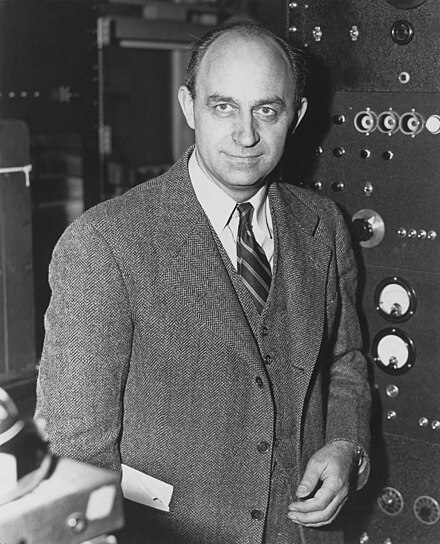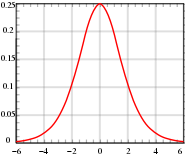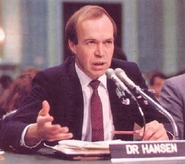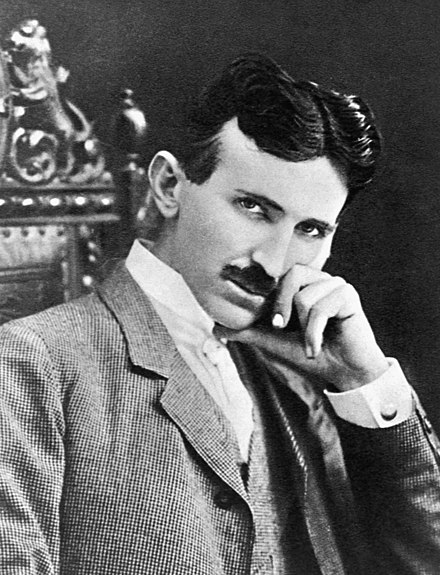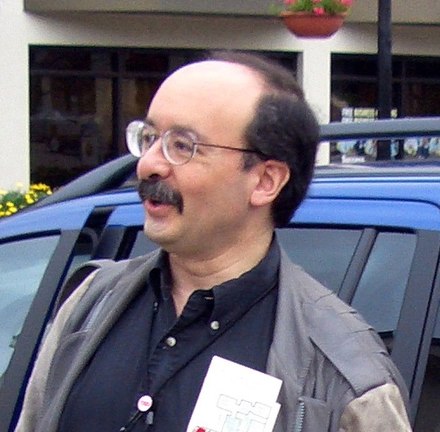Portal:Energy/Selected biography
Selected biography 1
Portal:Energy/Selected biography/1
Michael Faraday (1791 – 1867), an English chemist and physicist, is credited with the discovery of electromagnetic induction, which formed the basis for exploiting electricity as a practical form of energy. His discovery paved the way for the development of generators, induction motors, transformers, and most other electrical machines.In 1831, Faraday began his great series of experiments in which he discovered electromagnetic induction. He established that a changing magnetic field produces an electric field, a relation mathematically modelled by Faraday's law. Faraday later used the principle to construct the electric dynamo, the ancestor of modern power generators. He went on to investigate the fundamental nature of electricity, concluding in 1839 that, contrary to opinions at the time, only a single "electricity" exists, and the changing values of quantity and intensity (voltage and charge) would produce different groups of phenomena.
Some historians refer to Faraday as the best experimentalist in the history of science. Despite this his mathematical ability did not extend so far as trigonometry or any but the simplest algebra. He nevertheless possessed the ability to present his ideas in clear and simple language. During his lifetime, Faraday rejected a knighthood and twice refused to become President of the Royal Society.
Selected biography 2
Portal:Energy/Selected biography/2
Enrico Fermi (September 29, 1901 – November 28, 1954) was an Italian physicist most noted for his work on the development of the first nuclear reactor, and for the development of quantum theory. Fermi won the 1938 Nobel Prize in Physics for his work on induced radioactivity.Fermi was well-known for his simplicity in solving problems. Whenever possible, he avoided complicated mathematics and obtained quick results based on order of magnitude estimates. Fermi also meticulously recorded his calculations in notebooks, and later used to solve many new problems that he encountered based on these earlier known problems.
After accepting the 1938 Nobel Prize in Stockholm, Fermi immigrated to New York with his family to escape the anti-Semitic laws of Fascist Italy, as his wife Laura was Jewish.
After working at Columbia University, Fermi went to the University of Chicago and began studies that led to the construction of the world's first nuclear reactor Chicago Pile-1 (CP-1). The first artificial, self-sustaining, nuclear chain reaction was initiated within CP-1, on December 2, 1942.
Selected biography 3
Portal:Energy/Selected biography/3
James Watt (19 January 1736 – 19 August 1819) was a Scottish inventor and engineer. His improvements to the steam engine, which had hardly changed for fifty years, produced a source of power that transformed the world of work, and was the key innovation that brought forth the Industrial Revolution.In recognition of Watt's achievements, the SI unit of power, the watt, is named after him.
James Watt was born on 19th of January, 1736 in Greenock, a seaport on the Firth of Clyde. His father was a shipwright, shipowner and contractor, while his mother, Agnes Muirhead, came from a distinguished family and was well-educated. Both were Presbyterians and strong Covenanters. Watt attended school irregularly and instead was mostly schooled at home by his mother.
After studying instrument-making for a year in London, the University of Glasgow offered him the opportunity to set up a small workshop within the university. It was established in 1757. After four years, Watt began to experiment with steam, finally producing a working model steam engine in 1765. Strapped for resources to develop a full-scale engine, Watt was forced to take up employment as a surveyor for eight years. Finally, in 1776, the first engines were installed and working in commercial enterprises.
After further improvements, Watt and foundry owner Matthew Boulton established Boulton and Watt in 1794 to exclusively manufacture steam engines. By 1824 it had produced 1,164 steam engines having a total nominal horsepower of about 26,000.
Selected biography 4
Portal:Energy/Selected biography/4
Thomas Alva Edison (February 11, 1847 – October 18, 1931) was an American inventor and businessman who developed many devices which greatly influenced life worldwide into the 21st century. Dubbed "The Wizard of Menlo Park" by a newspaper reporter, he was one of the first inventors to apply the principles of mass production to the process of invention, and can therefore be credited with the creation of the first industrial research laboratory.Edison invented the first commercially practical electric light bulb which, by 1879 would burn for hundreds of hours. He was able to sell the concept to homes and businesses by mass-producing them and creating a complete system for the generation and distribution of electricity.
Edison patented an electric distribution system in 1880, and in January 1882 he switched on the first steam generating power station at Holborn Viaduct in London, UK. The direct current (DC) supply system provided electricity supplies to street lamps and a number of private dwellings within a short distance of the station. The first investor-owned electric utility, Pearl Street Station, New York City, started generating on September 4, 1882, providing 110 volts direct current to 59 customers in lower Manhattan.
Life magazine (USA), in a special double issue, placed Edison first in the list of the "100 Most Important People in the Last 1000 Years," noting that the light bulb he promoted "lit up the world." He was ranked thirty-fifth on Michael H. Hart's list of the most influential figures in history.
Selected biography 5
Portal:Energy/Selected biography/5
William Thomson, 1st Baron Kelvin, OM, GCVO, PC, PRS, FRSE, (26 June 1824 – 17 December 1907), widely known for developing the Kelvin scale of absolute temperature measurement, was a mathematical physicist, engineer, and outstanding leader in the physical sciences of the 19th century. He did important work in the mathematical analysis of electricity and thermodynamics, and did much to unify the emerging discipline of physics in its modern form.Born in Ireland, Thomson studied at the University of Glasgow, Scotland. On graduating, he became a mathematics teacher at the Royal Belfast Academical Institution. During his life Thomson published more than 600 scientific papers and filed over 70 patents.
As early as 1845 Thomson pointed out that the experimental results of William Snow Harris were in accordance with the laws of Coulomb. Over the period 1855 to 1867, Thomson collaborated with Peter Guthrie Tait the Treatise on Natural Philosophy that unified the various branches of physical science under the common principle of energy. His inventions included the current balance for the precise specification of the ampere, the standard unit of electric current.
In 1893, Thomson headed an international commission to decide on the design of the Niagara Falls power station. Despite his previous belief in the superiority of direct current electric power transmission, he agreed to use alternating current after seeing a Westinghouse demonstration at the Chicago World's Fair.
Selected biography 6
Portal:Energy/Selected biography/6
Marion King Hubbert (1903–1989) was a geophysicist who made several important contributions to geology and geophysics, most notably the Hubbert curve and Hubbert peak theory (or peak oil), with important political ramifications.Born in Texas, Hubbert studied geology, mathematics, and physics at the University of Chicago. He pursued his Ph.D. while working for the Amerada Petroleum Company, then worked for the Shell Oil Company from 1943 until 1964. On leaving Shell he became a senior research geophysicist for the United States Geological Survey until retiring in 1976. Hubbert was also a professor at Stanford University and at UC Berkeley.
Hubbert is most well-known for his studies on the capacities of oil fields and natural gas reserves. He predicted that, for any given geographical area, the rate of petroleum production over time would resemble a bell curve. At the 1956 meeting of the American Petroleum Institute, Hubbert predicted that United States petroleum production would peak in the late 1960s or early 1970s. He became famous when his prediction came true in 1970.
In 1974, Hubbert projected that global oil production would peak in 1995 "if current trends continue". Various subsequent predictions have been made by others as trends have fluctuated in the intervening years. Hubbert's theory, and its implications for the world economy, remain controversial.
Selected biography 7
Portal:Energy/Selected biography/7
John Davison Rockefeller, Sr. (July 8, 1839 – May 23, 1937) was a controversial American industrialist who revolutionized the oil industry and defined the structure of modern philanthropy. He is often regarded as the richest person in history.Rockefeller founded the Standard Oil Company in 1870 and ran it until he retired in the late 1890s. He continued to retain his stock and his title as president until 1911, when the company was broken up for carrying out illegal monopoly practices. The new companies formed included the predecessors of Conoco, Amoco, Chevron, Esso, Mobil and Sohio. Rockefeller, who had rarely sold shares, owned stock in all of them. As gasoline had grown in importance his wealth had soared and he became the world's richest man and the first billionaire.
Rockefeller's fortune was used to create the modern systematic approach of targeted philanthropy with foundations that had a major impact on medicine, education, and scientific research. His foundations pioneered the development of medical research, and was instrumental in the eradication of hookworm and yellow fever. At his death, at the age of 98, Rockefeller's remaining fortune was estimated at $1.4 billion. As a percentage of the United States economy, no other American fortune has ever come close.
Selected biography 8
Portal:Energy/Selected biography/8
Roman Arkadyevich Abramovich (born 24 October 1966 in Saratov, Russia) is a Jewish Russian oil billionaire and one of the Russian oligarchs.Between 1992 and 1995, after Soviet president Mikhail Gorbachev's 'perestroika' economic reforms permitted the opening of small private businesses, Abramovich founded five companies that eventually evolved to specialize in the trading of oil and oil products. With the approved by Boris Yeltsin, in 1995 Roman Abramovich and partner Boris Berezovsky paid $100m for a controlling interest in the major Russian Sibneft oil company, then valued at $150 million. Berezovsky subsequently sold his stake to Abramovich after fleeing to London. In September 2005 Abramovich sold his interest in Sibneft to state energy giant Gazprom for $13 billion.
Despite maintaining that his primary residence is Moscow, in 2006 Abramovich was named as the second-wealthiest person in the United Kingdom. His property investments and other assets were estimated at £10.8 billion. In June 2003, Abramovich became the owner of the companies that control Chelsea Football Club (soccer club). He also became the world's greatest spender on luxury yachts, with four boats in what the media have called the 'Abramovich Navy'.
Although he rarely visits the area, in October 2005 Abramovich was reappointed governor of the impoverished Chukotka Autonomous Okrug in the Russian Far East where he has made significant financial contributions. He was originally elected to the governorship in 1999.
Selected biography 9
Portal:Energy/Selected biography/9
James Clerk Maxwell (13 June 1831 – 5 November 1879) was a Scottish mathematician and theoretical physicist. His most significant achievement was formulating a set of equations – eponymously named Maxwell's equations – that for the first time expressed the basic laws of electricity and magnetism in a unified fashion. Maxwell's contributions to physics are considered by many to be of the same magnitude as those of Isaac Newton and Albert Einstein.Maxwell studied natural philosophy, moral philosophy, and mental philosophy at the University of Edinburgh, before graduating in mathematics at the University of Cambridge, where he would conduct much of his career. He built on Michael Faraday's work on magnetic induction, using elements of geometry and algebra to demonstrate that electric and magnetic fields travel through space, in the form of waves, and at the constant speed of light. Finally, in 1861, Maxwell proposed that light consisted of undulations in the same medium that is the cause of electric and magnetic phenomena. In the same year he was elected to the Royal Society.
In 1864, Maxwell presented what are now known as Maxwell's equations to the Royal Society. These collectively describe the behaviour of both the electric and magnetic fields, as well as their interactions with matter.
Selected biography 10
Portal:Energy/Selected biography/10
James E. Hansen (born March 29, 1941) heads the NASA Institute for Space Studies and is currently an adjunct professor in the Earth and Environmental Sciences department at Columbia University. He is best known for his testimony on climate change to congressional committees in the 1980s that helped raise broad awareness of global warming.Hansen studied at the University of Iowa, obtaining a B.A. in Physics and Mathematics, an M.S. in Astronomy and a Ph.D. in Physics. He was elected to the National Academy of Sciences in 1996 and received the Heinz Environment Award for his research on global warming in 2001.
Hansen is a vocal critic of the Bush Administration's ideology on climate change. In 2005 and 2006, he claimed that NASA administrators have tried to influence his public statements about the causes of climate change. He has also claimed that the White House edited climate-related press releases from federal agencies to make global warming seem less threatening, and that he is unable to speak 'freely', without the backlash of other government officials.
Hansen has said that a global tipping point will be reached by 2016 if levels of greenhouse gases are not reduced. After this point global warming becomes unstoppable. As a result he claims that there may be a rise in sea levels by as much as 10 feet (3 metres) by 2100.
Selected biography 11
Portal:Energy/Selected biography/11
Albert Arnold "Al" Gore, Jr. (born 31 March 1948) is an American politician, teacher, businessman, and environmentalist. From 1993 to 2001, he was the 45th Vice President of the United States, serving while Bill Clinton was President. In the 2000 election Gore won the popular vote but not the electoral college victory.Gore lectures widely on the topic of global warming and has given his keynote presentation at least 1,000 times across the world. In 2006 he starred in the Academy Award-winning documentary An Inconvenient Truth, discussing global warming and the environment, based on his presentation.
Gore was one of the first politicians to grasp the seriousness of climate change and to call for a reduction in greenhouse gas emissions. He held the first congressional hearings on the subject in the late 1970s. Gore pushed strongly for the passage of the Kyoto Treaty in the United States during the late 1990s.
In 2007 Al Gore and Richard Branson announced the Virgin Earth Challenge, offering a $25 million prize for the first viable design which results in the removal of atmospheric greenhouse gases. He is also one of the backers of the Live Earth concerts to promote action on climate change.
Selected biography 12
Portal:Energy/Selected biography/12 Sheikh Ahmed Zaki Yamani (born 1930) was Saudi Arabia's Minister of Oil (Petroleum) and Mineral Resources from 1962 until 1986, and a minister in OPEC for 25 years. He is best known for his role in the 1973 oil crisis, when OPEC quadrupled the price of crude oil.
Yamani gained a degree from Harvard Law School and a master's in Comparative Jurisprudence from New York University. After working in the Saudi Ministry of Finance, in 1958 he became a legal advisor to Faisal, then Crown Prince and Prime Minister, until Faisal's resignation in 1960. After Faisal's return to government, in 1962 Yamani replaced Abdallah Tariki as Oil Minister, playing an important role in the development of OPEC. During the 1967 Arab–Israeli War Yamani spoke against the use of an Arab oil embargo. The following year he led the founding of the Organization of Arab Petroleum Exporting Countries.
When Arab–Israeli hostilities resumed with the 1973 Yom Kippur War, the pressure to join the other Arab states, who wished to use oil to change the apparent pro-Israeli policy of the United States government, was irresistible. Yamani's proposal of increasing monthly cuts in production was accepted and, together with a later embargo against the US and the Netherlands and a quadrupling of the oil price, severely affected the economies of all western nations. Despite this, by resisting more extreme proposals Yamani became increasingly seen as pro-American in the Arab world.
Selected biography 13
Portal:Energy/Selected biography/13 Enrico Mattei (1906 - 1962) was an Italian public administrator. After World War II he enlarged and reorganized Agip, the Italian Petroleum Agency established by the former Fascist regime, to create Ente Nazionale Idrocarburi (ENI), the National Fuel Trust. He also introduced the international principle whereby a country that owns oil reserves receives 75% of the profits from their exploitation, and helped break the oligopoly of the 'Seven Sisters' that dominated the mid 20th century oil industry.
Enrico Mattei was born in Acqualagna, the son of a carabiniere. At the age of 24 he moved to Milan, where he worked in various jobs and later joined the Resistenza and became a well known partisan. In 1945, the Comitato di Liberazione Nazionale gave him instructions to close Agip; instead, he turned the company into one of the nation's major economic assets. When ENI was formed in 1953, subsuming Agip, Mattei became its president, then also the administrator and the general director. To break the oligopoly of the oil majors, Mattei initiated agreements with the poorest countries of the Middle East and with those of the Soviet bloc. He agreed a 50–50 partnership for extracting oil in Tunisia and Morocco, and offered Iran and Egypt that the risks of oil exploration would be entirely ENI's.
Behind the scenes, Mattei secretly financed the independence movement against colonialist France in the Algerian War, and was also alleged to have engaged in extensive bribery, especially of politicians and journalists. His death in a plane crash is claimed by some to have been murder. In 2000, the Trans-Mediterranean Pipeline was named after him.
Selected biography 14
Portal:Energy/Selected biography/14
Nikola Tesla (10 July 1856 – 7 January 1943) was an inventor, electrical engineer, mechanical engineer, and futurist best known for his contributions to the design of the modern alternating current (AC) electricity supply system.He gained experience in telephony and electrical engineering before immigrating to the United States in 1884 to work for Thomas Edison in New York City. He soon struck out on his own with financial backers, setting up laboratories and companies to develop a range of electrical devices. His patented AC induction motor and transformer were licensed by George Westinghouse, who also hired Tesla for a short time as a consultant. His work in the formative years of electric power development was also involved in the corporate struggle between making alternating current or direct current the power transmission standard, referred to as the War of Currents. Tesla went on to pursue his ideas of wireless lighting and electricity distribution in his high-voltage, high-frequency power experiments in New York and Colorado Springs and made early (1893) pronouncements on the possibility of wireless communication with his devices. He tried to put these ideas to practical use in his ill-fated attempt at intercontinental wireless transmission, which was his unfinished Wardenclyffe Tower project. In his lab he also conducted a range of experiments with mechanical oscillators/generators, electrical discharge tubes, and early X-ray imaging. He also built a wireless controlled boat, one of the first ever exhibited.
In 1960 the General Conference on Weights and Measures named the SI unit of magnetic flux density the tesla in his honor.
Selected biography 15
Portal:Energy/Selected biography/15
Amory Bloch Lovins (born November 13, 1947) is an American physicist, environmental scientist, writer, and Chairman/Chief Scientist of the Rocky Mountain Institute. He has worked in the field of energy policy and related areas for four decades. He was named by Time magazine one of the World's 100 most influential people in 2009.Lovins worked professionally as an environmentalist in the 1970s and since then as an analyst of a "soft energy path" for the United States and other nations. He has promoted energy efficiency, the use of renewable energy sources, and the generation of energy at or near the site where the energy is actually used. Lovins has also advocated a "negawatt revolution" arguing that utility customers don’t want kilowatt-hours of electricity; they want energy services. In the 1990s, his work with Rocky Mountain Institute included the design of an ultra-efficient automobile, the Hypercar.
Lovins does not see his energy ideas as green or left-wing, and he is an advocate of private enterprise and free market economics. He notes that Rupert Murdoch has made News Corporation carbon-neutral, with savings of millions of dollars. But, says Lovins, large institutions are becoming more "gridlocked and moribund", and he supports the rise of "citizen organizations" around the world.
Lovins has received ten honorary doctorates and won many awards. He has provided expert testimony in eight countries, briefed 19 heads of state, and published 29 books. These books include Reinventing Fire, Winning the Oil Endgame, Small is Profitable, Brittle Power, and Natural Capitalism.
Selected biography 16
Portal:Energy/Selected biography/16

Benjamin K. Sovacool is Director of the Danish Center for Energy Technology at AU Herning and a Professor of Social Sciences at Aarhus University in Denmark. He is also Associate Professor at Vermont Law School and Director of the Energy Security and Justice Program at their Institute for Energy and the Environment. Sovacool's research interests include energy policy, environmental issues, and science and technology policy, and his research has taken him to 50 countries. He is the author or editor of sixteen books and 250 peer reviewed academic articles. Sovacool's work has been referred to in academic publications such as Science, Nature, and Scientific American. He has written opinion editorials for the Wall Street Journal and the San Francisco Chronicle. Sovacool is an Intergovernmental Panel on Climate Change Contributing Author. Read More...
More selected biographies
Selected biography 17
Portal:Energy/Selected biography/17

Michael Grätzel (born 11 May 1944, in Dorfchemnitz, Saxony, Germany) is a professor at the École Polytechnique Fédérale de Lausanne where he directs the Laboratory of Photonics and Interfaces. He pioneered research on energy and electron transfer reactions in mesoscopic-materials and their optoelectronic applications. He co-invented with Brian O'Regan the Grätzel cell in 1988.
Graetzel is the author of over 1000 publications, two books and inventor or co-inventor of over 80 patents, he has been the Mary Upton Visiting Professor at Cornell University and a distinguished visiting professor at the National University of Singapore, and is currently a distinguished scientist at King Abdulaziz University. He was an invited professor at the University of California, Berkeley, the École normale supérieure Paris-Saclay and Delft University of Technology. (Full article...)
More selected biographies

